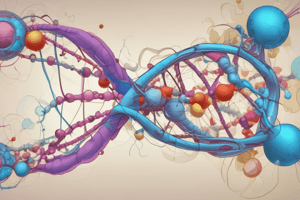Podcast
Questions and Answers
What is the primary function of DNA in living organisms?
What is the primary function of DNA in living organisms?
- To store energy for cellular processes
- To act as a catalyst for biochemical reactions
- To serve as hereditary material (correct)
- To provide structural support to cells
Where is DNA located in eukaryotic cells?
Where is DNA located in eukaryotic cells?
- In the cytoplasm
- In the cell membrane
- In the ribosomes
- In the nucleus (correct)
How does DNA ensure the new cell receives the correct genetic information during cell division?
How does DNA ensure the new cell receives the correct genetic information during cell division?
- By replicating itself (correct)
- By breaking down proteins
- By undergoing mutations
- By exchanging genetic material with other cells
Which statement about DNA in prokaryotic cells is true?
Which statement about DNA in prokaryotic cells is true?
What substance is DNA primarily composed of?
What substance is DNA primarily composed of?
Flashcards are hidden until you start studying
Study Notes
DNA Overview
- DNA stands for deoxyribonucleic acid, which is the hereditary material in all living organisms.
- Found within the nucleus of eukaryotic cells and in the nucleoid region of prokaryotic cells.
Replication Process
- DNA has the ability to replicate itself, ensuring genetic continuity.
- When cells divide, each new cell receives an exact copy of the DNA from the parent cell.
Role in Heredity
- DNA carries genetic information necessary for the growth, development, and functioning of living organisms.
- It is crucial for transmitting traits from one generation to the next.
Studying That Suits You
Use AI to generate personalized quizzes and flashcards to suit your learning preferences.




